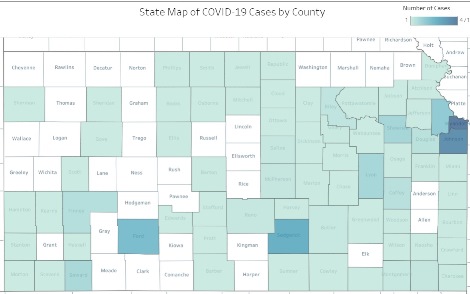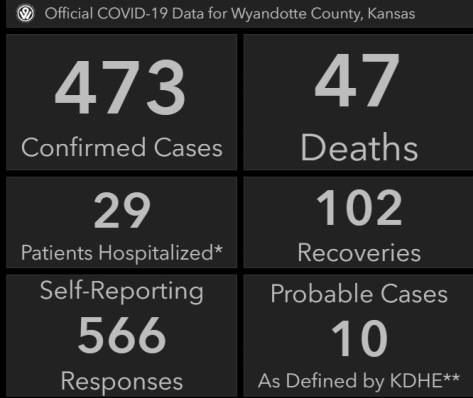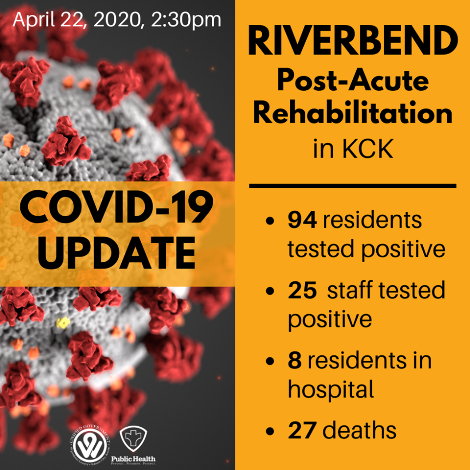


Kansas reported an additional 186 positive COVID-19 cases today, bringing the state total to 2,211 cases.
The state reported a total of 110 deaths, up three deaths from Tuesday, according to Gov. Laura Kelly.
Wyandotte County, as of the 4:30 p.m. April 22 report, had two more deaths than the 8:25 a.m. report April 21, according to the Unified Government COVID-19 webpage. There were 47 more cases, for a total of 473 positive cases in Wyandotte County.
The UG Health Department stated that two new deaths were reported today at Riverbend Post-Acute Rehabilitation facility in Kansas City, Kansas, for a total of 27 deaths at that facility.
At a news conference today, Gov. Kelly said she had signed an emergency order to allow the temporary easing of licensing requirements for advanced practice registered nurses, physician’s assistants and licensed practical nurses. The order allows those who were recently inactive to practice, and allows enrolled students to volunteer or work within facilities, she said.
The order will help the health care system have more flexibility to make sure hospitals are not overwhelmed by the COVID-19 pandemic, she said.
Dr. Lee Norman, Kansas secretary of health, said the new order would not necessarily increase the number of health care workers, but it would allow some to work without direct supervision. It would particularly help rural areas, he said.
Gov. Kelly said there will be a gradual rollout for reopening the Kansas economy.
“There is no blueprint for what comes next,” she said. It is far more complicated than flipping a switch or rescinding an emergency order, she added.
Gov. Kelly said public safety must be paramount. The Trump administration stated last week the transition couldn’t take place until the state passes its peak and the number of cases begins to decline.
Gov. Kelly said while there are many reasons to be optimistic, Kansas is not yet at the point it needs to be to reopen. COVID-19 will need to decline, she said.
The governor has been meeting with county and local health departments to identify the needs of health care workers to reopen the economy and protect public health before a vaccine is developed.
She said specific benchmarks must be identified for Kansas to reopen safely.
The recovery timeline will be determined by testing capacity, hospital surge capacity, personal protection equipment supply and contact tracing, Gov. Kelly said. There will be benchmarks attached to these categories in the next week, she added.
The governor also said that reopening must be regionally targeted and industry specific. She said she has held discussions with the Kansas City Chamber and the Sedgwick County Chamber of Commerce. This afternoon, she planned to have discussions with the Kansas Chamber of Commerce.
Gov. Kelly said all discussions with the business community have indicated that safety will be paramount in reopening. Their response will weigh heavily in this process, she said.
The governor also said she will collect responses from sectors such as the hospitality industry, retail and barbers and hairstylist, among others.
In the next five days, the governor said she plans more discussions with health care providers, local units of government, labor leaders and the faith community.
In addition, she said she is coordinating the state’s efforts with neighboring states of Missouri and Colorado, and also will talk with Kansas City, Missouri, Mayor Quinton Lucas about working together.
Gov. Kelly said she would release more comprehensive information about the next phase by the end of next week.
Dr. Norman said the state currently is monitoring 45 clusters of COVID-19 cases.
Seventeen were in long-term care facilities, including 348 cases and 58 deaths, he said.
Other clusters included two group living facilities with 27 cases and no deaths; one correctional facility, Lansing Correctional Facility, with 82 cases and no deaths; two health care facilities with 16 cases and no deaths; five religious gatherings with 85 cases and seven deaths; 19 private companies with 81 cases and no deaths; and six meatpacking facility clusters with 168 cases and no deaths.
Dr. Norman said the state Health Department and Kansas Department for Aging and Disability Services are working together with the Centers for Medicare and Medicaid Services to review infection control practices, patient safety and staff safety. He said the facility should be able to go back to a full and normal existence once there is cleaning and a number of days have passed.
Testing in Kansas now has been broadened, he said. Previously, a fever and cough were a requirement to be tested. As of Tuesday, the state no longer requires fever for testing, nor a cough. Instead, the patient must have two symptoms, which can be fever, chills, body aches, sore throat or other symptoms listed on the state’s website.
Dr. Norman said the CDC has acknowledged that as more testing is done, they are finding COVID-19 cases that did not have fever or cough.
Some additional testing is taking place in Wyandotte County and other areas.
Over the next few days, Kansas may see a jump in cases, he said. The state probably is right about at the peak right now, although that won’t be certain until more time passes, he said.
Increased testing around meatpacking plants in southwest Kansas are finding more and more cases minimally symptomatic or asymptomatic, he said. Some of the smaller counties may have manual entry of test results that may mean the state’s totals are lagging a few days, he added.
Dr. Norman said he doesn’t see more testing as negative. Wider testing will result in increased numbers, and it will help the state target where they need to be, he said. The health departments are doing contact tracing on positive cases, in order to isolate them, while they get ready to reopen.
Dr. Norman said the state received a batch of 3,000 swabs for testing this afternoon, from a third printing that started April 18. Local dentists are producing 10,000 swabs a week. By the end of the week there will be an increase of 7,000, so that swabs won’t be a limiting factor for testing in the future.
On the topic of how COVID-19 deaths are recorded, Dr. Norman said the cause of death is reported by the attending physician. The physician follows guidelines based on guidance from the CDC. There are some cases where there are comorbidities, and doctors will use their best judgment to determine the cause.
Dr. Norman is issuing a caution about serology tests for COVID-19.
He said there were more than 100 serology testing platforms before the FDA, and the tests do not have FDA approval.
The tests should not be used alone to say if a person has had COVID-19 or not. The serology tests should be combined with one of the molecular tests being given throughout the state, he said.
According to Dr. Norman, some of the serology tests might indicate that a person had coronavirus, but not the novel coronavirus COVID-19. That test could show a positive result for just a cold. If a decision is made to put someone on a COVID-19 ward because of a serology test result, and relax personal protective equipment requirements, then that person would be very vulnerable to COVID-19, and it would not serve them well, he said.
Self-administered tests at home, approved by the FDA, are a good idea, he said, especially if they keep people who have symptoms out of the doctors’ offices and emergency rooms and away from other people. At home, they can continue to isolate, he said.
Dr. Norman said he was certain that there would be a second wave of COVID-19 into the fall and winter. If it follows the patterns of past epidemics, there would be a higher peak than there is at the first peak.
Health officials have done a lot of things to push down the number of cases, he said, and broader testing will help them target certain areas where there are higher problems. They can go to problem areas and work there, he said.
Gov. Kelly said there were three phases under the White House guidelines. If they get to the third phase and a new wave hits, they would start pulling it back, she said.
A county commission in the Wichita area has discussed herd immunity as the solution, and Dr. Norman said that would be a bad idea.
Herd immunity is when a sufficient number of people in the population get a virus, and don’t transmit it because everybody has already had it. It’s a good idea if it is a minor illness without a lot of deaths associated with it, but a bad idea for COVID-19, he said. The nation would have deaths in the six or seven figures if that were done, he said. The more modern approach would be to do the other mitigating efforts, push as many cases into the future as possible, then have a vaccine and get herd immunity through the vaccine, Dr. Norman said.
To view the governor’s news conference, visit https://www.facebook.com/GovLauraKelly/videos/233133637768654/.
The Kansas COVID-19 resource page is at https://govstatus.egov.com/coronavirus.
The UG’s COVID-19 webpage is at https://alpha.wycokck.org/Coronavirus-COVID-19-Information.
